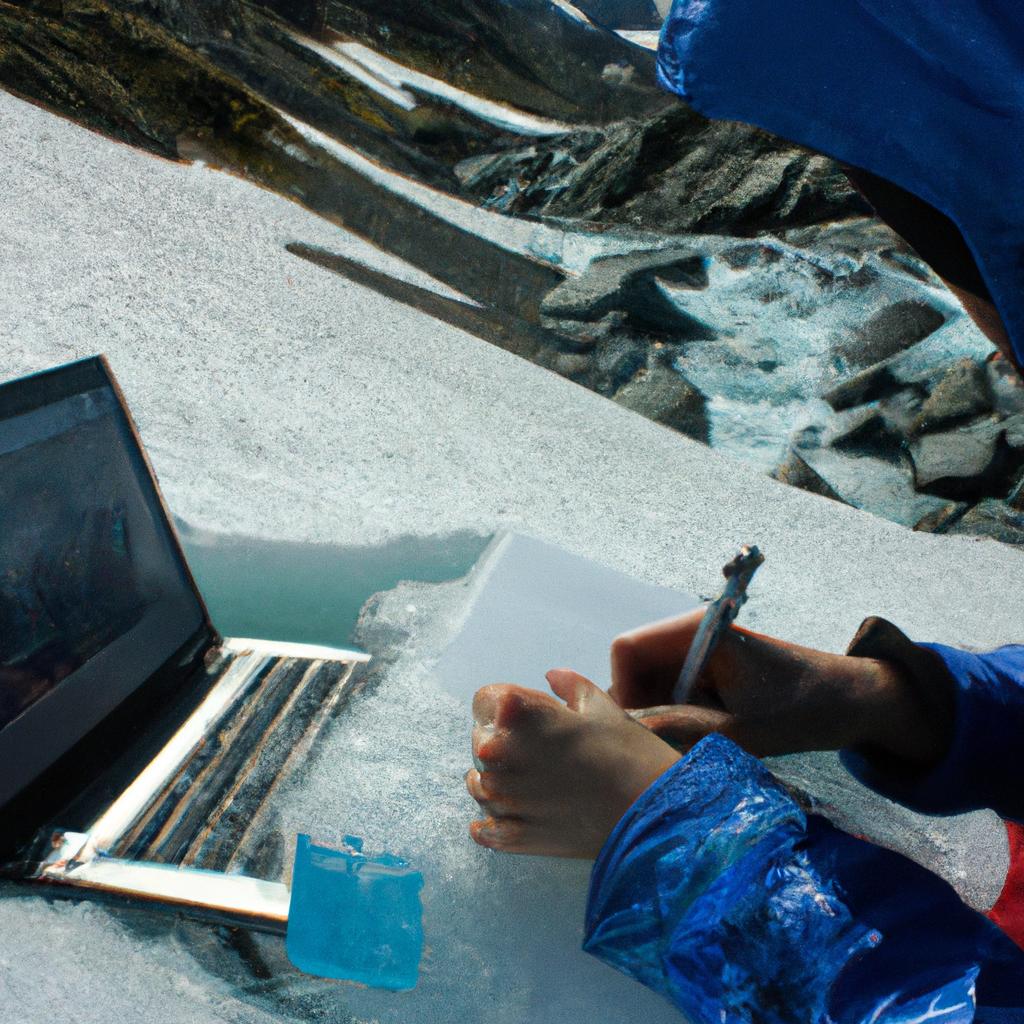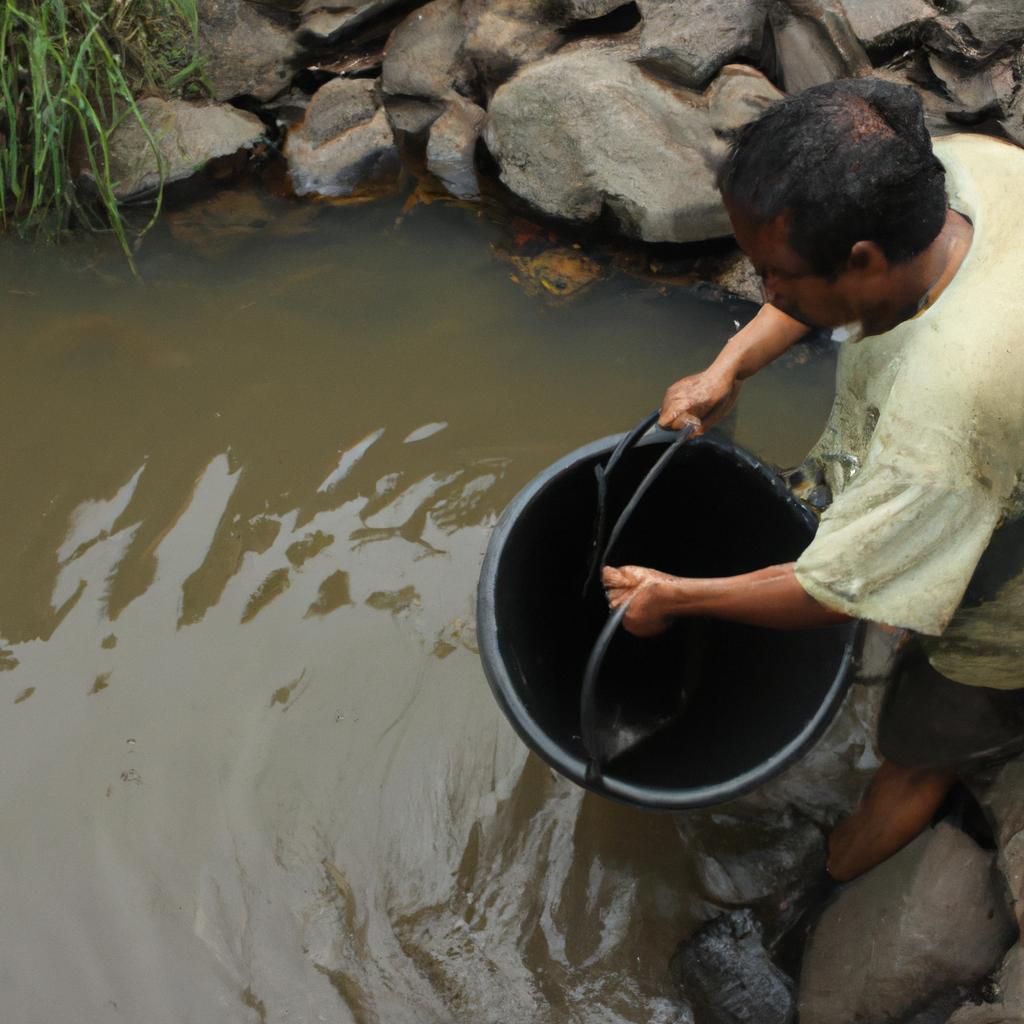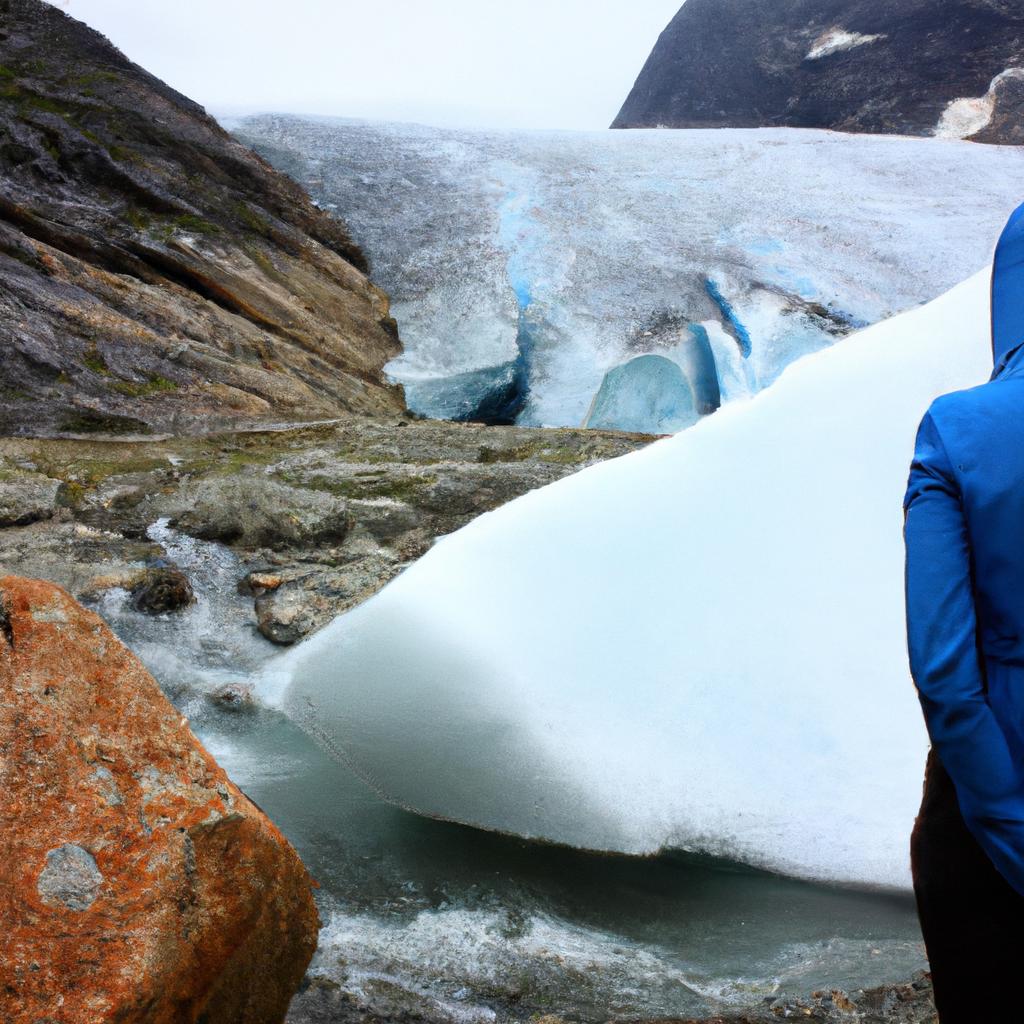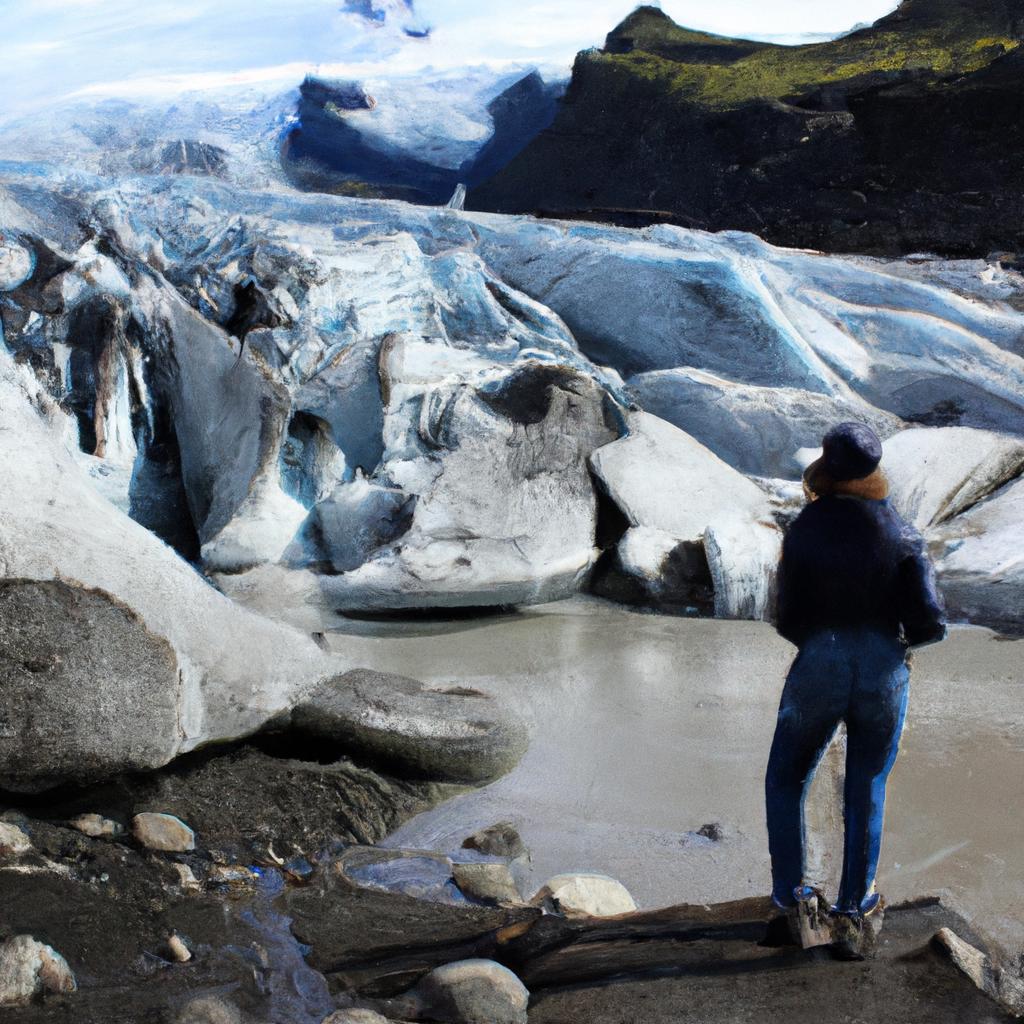Glacier melting and climate change have become increasingly significant global issues with profound social and economic implications. The rapid retreat of glaciers, such as the Greenland Ice Sheet, poses a substantial threat to coastal communities around the world due to rising sea levels. For instance, let us consider an imaginary case study of a small island nation located in the Pacific Ocean. As a result of glacier melt-induced sea level rise, this nation’s low-lying coastal areas are at risk of being submerged, displacing thousands of inhabitants and causing massive infrastructure damage. This example highlights just one aspect of the complex web of consequences that arise from the melting of glaciers.
Beyond its immediate effect on vulnerable communities, the melting of glaciers also has far-reaching economic ramifications. Glaciers serve as natural reservoirs, storing vast amounts of freshwater that gradually release water downstream during dry seasons. With their disappearance or reduction in size, many regions will experience increased water scarcity leading to detrimental impacts on agriculture, hydropower generation, and other sectors dependent on reliable water supplies. Furthermore, tourism industries built around breathtaking glacial landscapes may suffer severe losses when these features vanish or significantly shrink due to melting. Consequently, it is imperative to explore and understand the social and economic implications stemming from glacier melt-induced climate change in order to develop effective strategies for adaptation and mitigation.
One way to address the social implications of glacier melt-induced climate change is through proactive measures to protect vulnerable communities. This may involve implementing coastal defense systems, relocating populations from at-risk areas, or providing support for adaptation initiatives such as constructing resilient infrastructure. Additionally, efforts should be made to ensure equitable access to resources and opportunities for affected communities, particularly those that rely heavily on natural resources impacted by glacier melt.
In terms of economic implications, diversification of industries and job markets can help mitigate the negative impacts of glacier melting. This could involve investing in alternative sectors such as renewable energy, sustainable agriculture practices, or eco-tourism focused on non-glacial attractions. Furthermore, promoting research and innovation in water management technologies can help mitigate the effects of reduced freshwater availability in regions dependent on glacial meltwater.
It is also crucial to engage in international cooperation and advocacy to address glacier melting and climate change on a global scale. Encouraging nations to reduce greenhouse gas emissions and implement sustainable development practices can contribute to slowing down the rate of glacier melt. Moreover, supporting scientific research and knowledge-sharing initiatives can enhance our understanding of these processes and inform evidence-based policies.
In conclusion, the social and economic implications of glacier melting induced by climate change are multifaceted and demand comprehensive responses. By addressing both immediate impacts on vulnerable communities and long-term consequences on various economic sectors, we can work towards building a more resilient future while mitigating further environmental damage caused by glacier melt.
Rise in sea levels
Rise in Sea Levels
The consequences of melting glaciers due to climate change are far-reaching, with one significant impact being the rise in sea levels. This section explores the social and economic implications associated with this phenomenon.
To better understand the gravity of the situation, let us consider a hypothetical case study involving an island nation in the Pacific Ocean. The country’s low-lying coastal areas have already experienced noticeable increases in sea level over the past decade. As a result, many communities residing near these vulnerable coastlines have been forced to relocate or adapt their lifestyles drastically.
The rising sea levels pose several threats that need urgent attention:
- Increased risk of flooding: Low-lying regions face a higher likelihood of inundation during high tides and storm surges, endangering both property and human lives.
- Erosion and loss of land: As waves intensify and reach further inland, erosion becomes more pronounced, leading to the loss of valuable agricultural lands and vital infrastructure such as roads and buildings.
- Salinization of freshwater sources: With seawater intruding into underground aquifers, there is a heightened risk of salinity contamination in freshwater resources, rendering them unusable for drinking water or irrigation purposes.
- Disrupted ecosystems: Coastal habitats like mangroves provide crucial protection against storms while serving as nurseries for marine life. However, rising sea levels threaten these delicate ecosystems, resulting in biodiversity loss and impacting local fishing industries.
| Social Implications | Economic Impact | Environmental Consequences |
|---|---|---|
| Displacement | Decline in tourism | Loss of biodiversity |
| Increased migration | Property damage | Ecosystem disruption |
| Health risks | Infrastructure | Reduced fish stocks |
| Conflict over resources | Agricultural losses | Degraded ecosystem services |
In light of these challenges, it is evident that urgent action must be taken to address the rise in sea levels. Governments and international organizations need to collaborate on implementing adaptation strategies, such as building resilient infrastructure and developing sustainable coastal management plans. Additionally, raising awareness among communities about the risks they face is vital for fostering collective action.
Transitioning into the subsequent section about “Loss of freshwater resources,” it becomes clear that addressing one consequence of melting glaciers does not alleviate all related concerns. The impact of rising sea levels extends beyond immediate coastal areas, affecting other interconnected aspects of human life and ecosystems worldwide.
Loss of freshwater resources
Section H2: Loss of Freshwater Resources
As the Earth’s glaciers continue to melt due to climate change, one major concern is the loss of freshwater resources. The implications of this phenomenon are far-reaching and have significant social and economic consequences. To illustrate these implications, let us consider the case study of Glacier National Park in Montana, USA.
Glacier National Park, known for its stunning landscapes and pristine lakes fed by glacial runoff, has experienced a drastic reduction in its glacier coverage over the past century. Once home to approximately 150 glaciers, it now has fewer than 30 remaining. This decline not only affects the park’s ecosystem but also presents challenges for local communities that rely on these freshwater sources for various purposes.
The loss of freshwater resources from melting glaciers poses several notable concerns:
- Water scarcity: With reduced glacial runoff feeding rivers and streams, there is a risk of water scarcity in regions dependent on these sources for agriculture, drinking water supply, and industrial activities.
- Disrupted ecosystems: Glaciers play a vital role in maintaining delicate ecological balances within their surrounding environments. As they disappear, changes occur in habitat availability for numerous species, leading to potential disruptions in biodiversity.
- Economic impact: Many industries heavily depend on access to reliable freshwater supplies. Sectors such as agriculture, tourism (including recreational activities like fishing), and energy production may face significant economic challenges if adequate measures are not taken to address water shortages.
- Geopolitical tensions: Scarce freshwater resources can become a source of conflict between nations or regions as competition intensifies for dwindling supplies.
To further grasp the gravity of these implications caused by melting glaciers, consider Table 1 below which outlines real-world statistics related to freshwater resource depletion:
| Implication | Statistics |
|---|---|
| Increased droughts | * Drought-affected population: 785 million people globally |
| * Annual economic losses: $6-8 billion | |
| Water scarcity | * 2.7 billion people face water shortages at least one month per year |
| * Half the world’s population will live in water-stressed areas by 2025 | |
| Ecological impacts | * Species extinction rates are 1,000 times higher due to habitat loss and climate change |
| * Loss of biodiversity negatively affects ecosystem stability |
In conclusion, the melting of glaciers not only contributes to rising sea levels but also results in the loss of freshwater resources. The case study of Glacier National Park highlights the social and economic implications associated with this phenomenon. From water scarcity and disrupted ecosystems to potential geopolitical tensions, it is evident that urgent action is needed to address these challenges effectively.
Looking ahead, we will now explore another significant consequence of climate change: the increased frequency of extreme weather events. This correlation between melting glaciers and extreme weather patterns further emphasizes the urgency for sustainable solutions.
Increased frequency of extreme weather events
Social and Economic Implications: Melting Glaciers and Climate Change
Loss of Freshwater Resources:
The loss of freshwater resources due to melting glaciers is a critical issue with far-reaching social and economic implications. As temperatures rise, glaciers around the world are rapidly shrinking, leading to a reduction in the availability of freshwater for various purposes. For instance, let us consider the case study of the Himalayan region where the Gangotri Glacier feeds into the Ganges River, upon which millions rely for their water supply and agriculture.
This alarming trend has several significant consequences:
- Water scarcity: Reduced glacier meltwater threatens the availability of clean drinking water for communities residing downstream. This can lead to increased competition and conflicts over limited water resources.
- Agricultural impacts: The decrease in freshwater availability affects agricultural productivity as irrigation becomes more challenging. Farmers relying on glacial meltwater face difficulties in cultivating crops, resulting in reduced yields and potential food shortages.
- Economic instability: The decline in agricultural output can have severe economic repercussions, particularly in regions heavily dependent on farming as a primary source of income. Communities that rely on these activities may experience heightened poverty levels and vulnerability to economic shocks.
- Migration patterns: In response to worsening conditions, individuals and communities may be forced to migrate from areas experiencing water scarcity towards more resource-rich regions, potentially triggering demographic changes and social tensions.
These consequences highlight the urgent need for proactive measures both at local and global scales to address the challenges arising from diminishing freshwater resources caused by melting glaciers.
Increased Frequency of Extreme Weather Events:
In addition to threatening freshwater supplies, climate change-induced glacier melt contributes significantly to an increase in extreme weather events worldwide. Rising temperatures disrupt atmospheric circulation patterns, leading to altered precipitation patterns characterized by intense rainfall or prolonged droughts. These changes result in a range of socio-economic impacts:
| Socio-Economic Impact | Examples |
|---|---|
| Infrastructure damage | Flooding and landslides caused by heavy rainfall can destroy roads, bridges, and buildings. |
| Loss of livelihoods | Droughts resulting from altered precipitation patterns can devastate agriculture and lead to job losses in rural communities dependent on farming. |
| Health risks | Extreme weather events such as hurricanes or heatwaves can pose significant health hazards, including injuries, waterborne diseases, and heat-related illnesses. |
| Displacement | Communities residing in low-lying coastal regions are particularly vulnerable to sea-level rise linked to glacier melt. They may face displacement due to flooding or the need for relocation. |
The increasing frequency and intensity of extreme weather events underscore the urgent need for adaptation strategies that address both short-term disaster response and long-term resilience building.
In light of these social and economic implications stemming from melting glaciers, it is crucial to recognize the interconnectedness between climate change, freshwater resources, extreme weather events, and their cascading effects on human societies. The subsequent section will explore another critical aspect affected by these changes: biodiversity loss. By understanding the multi-faceted impacts of glacier melt, we can develop comprehensive approaches towards mitigating its consequences for our planet’s ecological systems.
Impact on Biodiversity
Impact on biodiversity
As the Earth’s climate continues to warm due to human-induced factors, such as greenhouse gas emissions, the effects of melting glaciers become increasingly apparent. This section explores the impact of glacier retreat on biodiversity and its potential social and economic implications.
Impact on Biodiversity:
To illustrate the consequences of melting glaciers on biodiversity, let us consider a hypothetical case study in the Himalayas. The Gangotri Glacier, one of the largest glaciers in this region, has been retreating at an alarming rate over the past few decades. As it melts, unique habitats for numerous plant and animal species are being lost. One example is the snow leopard (Panthera uncia), which relies on these high-altitude ecosystems for survival. With shrinking glacial cover reducing their habitat range, populations have dwindled significantly.
The ramifications extend beyond individual species; entire ecosystems dependent on glacial meltwater face disruption. Here are some key points to consider:
- Reduction in freshwater availability: Glaciers act as natural reservoirs, storing water during colder periods and releasing it slowly throughout warmer seasons. Their disappearance leads to reduced freshwater resources for both humans and wildlife.
- Altered river flows: The loss of glaciers alters river dynamics by modifying flow patterns. Changes in water volume can affect agriculture, fisheries, hydropower generation, and transportation systems.
- Increased vulnerability of mountain communities: Many indigenous communities residing near glaciated regions heavily rely on ecosystem services provided by glaciers. Diminishing ice cover jeopardizes their livelihoods through impacts on agriculture, tourism, and other cultural practices.
- Loss of genetic diversity: Certain species that thrive in cold environments possess unique adaptations crucial for their survival. As glaciers recede, so does their gene pool diversity—a significant concern from an evolutionary perspective.
Table illustrating examples of social and economic implications:
| Social Implications | Economic Implications |
|---|---|
| Water scarcity for communities | Reduced agricultural productivity |
| Increased frequency of natural disasters | Decline in tourism revenue |
| Displacement of vulnerable populations | Higher costs for water management |
| Loss of cultural heritage | Impact on livelihoods |
Understanding the potential threats posed by melting glaciers goes beyond examining their impact on biodiversity. The subsequent section delves into the challenges faced by human settlements as a result of these changes, highlighting the need for proactive measures to mitigate risks.
Threats to human settlements
Impact on Biodiversity
The melting of glaciers due to climate change has far-reaching consequences, extending beyond just the environment. However, the implications stretch further and encompass various social aspects as well.
One real-life example that highlights these interconnected effects can be seen in the Himalayan region. The retreating glaciers have led to significant changes in the availability of water resources for both humans and wildlife. This alteration disrupts the delicate balance within ecosystems, affecting numerous species dependent on glacier-fed streams and rivers for their survival. Furthermore, it also affects human communities residing in these areas who rely on glacial meltwater for agriculture, drinking water, and hydropower generation.
The melting of glaciers poses several threats to human settlements across the globe:
- Increased risk of flooding: As glaciers shrink, they contribute more meltwater to rivers which can result in increased river flow and heightened flood risks downstream.
- Water scarcity: Glacial runoff acts as a natural reservoir during dry seasons or droughts; however, with reduced glacial volumes, there will be less water available for human consumption and agricultural activities.
- Displacement of coastal communities: Melting glaciers contribute to rising sea levels globally. This rise puts low-lying coastal communities at risk of inundation or forced migration.
- Economic instability: Communities reliant on industries such as tourism centered around glacier landscapes may experience economic repercussions due to diminishing attractions caused by vanishing ice formations.
To grasp the magnitude of these impacts, consider Table 1 below illustrating some potential consequences resulting from melting glaciers:
| Consequences | Description |
|---|---|
| Loss of habitat | Species adapted to cold environments lose their living space |
| Food chain disruption | Changes in aquatic systems affect entire food webs |
| Reduced crop yields | Decreased water availability leads to lower agricultural productivity |
| Infrastructure damage | Increased flooding damages roads, bridges, and buildings |
These consequences evoke the emotional response of concern for both ecological and human well-being. As societies face these challenges, it becomes crucial to develop strategies that prioritize adaptation and resilience.
Looking ahead, understanding the social and economic implications of melting glaciers is essential. This knowledge allows for informed decision-making in mitigating climate change impacts on vulnerable communities. In the subsequent section about “Economic consequences,” we will delve deeper into how the melting of glaciers affects various sectors such as tourism, agriculture, and energy production.
[Transition sentence: The repercussions extend beyond biodiversity alone; they also have significant economic consequences.]
Economic consequences
Transition from Previous Section:
Having explored the threats posed by melting glaciers to human settlements, it is crucial to examine the broader social and economic implications that arise as a result. The consequences extend far beyond immediate physical damage, affecting communities and economies in diverse ways.
Socioeconomic Disruption:
One significant consequence of melting glaciers is the disruption they cause to established socio-economic systems. To illustrate this point, let us consider the case study of an indigenous community residing near a glacier-dependent river in the Himalayas. As the glacier melts at an accelerated rate due to climate change, water scarcity becomes increasingly prevalent during critical months when glacial meltwater used to be abundant. This scarcity leads to conflicts over resources among local farmers who rely on irrigation for their crops. Additionally, reduced access to clean drinking water negatively impacts public health and increases vulnerability to waterborne diseases.
To better understand the wide-ranging effects of melting glaciers, we can turn our attention to key aspects impacted by this phenomenon:
- Livelihoods: Traditional occupations such as farming and herding are severely affected by changes in glacial patterns.
- Migration: Communities may face displacement as inhabitable land diminishes or becomes uninhabitable due to flooding or landslides triggered by retreating glaciers.
- Cultural Heritage: Indigenous cultures tied closely with glacial ecosystems experience erosion of traditional knowledge systems and cultural practices.
- Tourism: Glacier tourism, which often contributes significantly to local economies, dwindles as ice masses retreat and lose their allure.
Assessing Economic Losses:
The economic ramifications resulting from melting glaciers cannot be overlooked. A table below summarizes various sectors adversely affected by this environmental shift:
| Sector | Impact |
|---|---|
| Agriculture | Reduced crop yields due to changing precipitation patterns |
| Energy | Decline in hydropower generation as glacial meltwater diminishes |
| Water Supply | Increased costs of water treatment and supply infrastructure maintenance |
| Tourism | Loss of revenue from declining glacier-based tourism activities |
It is important to note that the economic losses mentioned above are not confined solely to local or regional scales. The impacts ripple through interconnected global markets, affecting trade patterns, commodity prices, and overall economic stability.
In light of these consequences, it becomes evident that addressing the issue of melting glaciers requires a comprehensive approach encompassing sustainable resource management, adaptation strategies, and international cooperation. Only by recognizing and mitigating the social and economic implications can we strive towards a more resilient future for communities affected by climate change.
Note: In conclusion, acknowledging the multifaceted nature of the challenges posed by melting glaciers necessitates urgent action on both local and global fronts. By implementing effective measures aimed at reducing greenhouse gas emissions, promoting sustainable development practices, and supporting vulnerable communities, we can work towards minimizing the societal upheaval caused by this environmental crisis.




